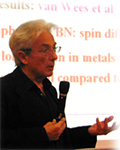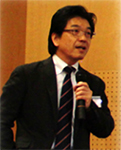

As part of its research area, “Research of Innovative Material and Process for Creation of Next-generation Electronics Devices” (Supervisor: Hisatsune Watanabe, EIDEC), CREST is currently involved in a research project on “Development of Graphene-on-Silicon Material/Device Technologies” (Representative: Taiichi Otsuji, Research Institute of Electrical Communication, Tohoku University). In line with this research project, CREST organized and hosted the 3rd International Symposium on Graphene Devices: Technology, Physics, and Modeling (ISGD 2012) from November 5 to 9, 2012. The five day symposium was held at the Synchrotron SOLEIL, located in Saint Aubin, near Paris, France. This symposium is the third one to be held, following the inaugural symposium in November 2008 (University of Aizu) and the second symposium in October 2010 (Tohoku University). The theme of this symposium was “technology, physics, and modeling,” pertaining to device applications for the new material, graphene, for which rapid advancements have been achieved. The success of the second symposium has heightened the momentum toward the development of an international organization among both Japanese and foreign researchers. Thus, in addition to members from Japan, representatives from France, United States, and Russia were also added to the JST-CREST GOS team last year to form an international committee. As a result, the symposium was convened outside of Japan for the first time, in France, Europe, under the leadership of a local organizing committee in France, chaired by Professor Patrick Soukiassian from Université de Paris-Sud.
A total of 21 researchers (including six researchers from Japan) who are positioned in the front lines of their research fields in both Japan and overseas, were invited to give guest lectures on their latest research achievements. In addition, 33 oral presentations (including five from Japan) and 27 poster presentations (including nine from Japan) were given, bringing the total number of presentations to 81. A total of 120 participants attended the event. The symposium was a great success, with an increase in the number of presentations to more than twice that of the first symposium (36 presentations) and 1.6 times that of the second symposium (51 presentations). In sessions spanning over five days, profound discussions were held on the latest research achievements in a diverse range of research areas relating to graphene devices. These included the unique physical properties of graphene centered on electronic transport, photoresponse, spin, and heat conductivity, evaluation and analysis technologies for crystalline growth, electronic and optical devices such as transistors, sensors, and lasers, logic gates, and signal processing devices.
A total of 21 researchers working in the frontlines of their respective fields of research were invited to speak at the symposium. Of these, 15 researchers had come from outside Japan, including Professor Walt A. de Heer (Georgia Institute of Technology, United States), Dr. Ulrich Starke (Max Plank Institute, Germany), Dr. Albert Fert (Thales, France), and Professor Stephane Roche (Catalan Institute, Spain), while six researchers had come from Japan—Professor Kazuhiko Matsumoto (Osaka University, Japan), Dr. Kazuhito Tsukagoshi (NIMS, Japan), Professor Toshio Ogino (Yokohama National University, Japan), Professor Taiichi Otsuji (Tohoku University, Japan), Professor Victor Rhyzii (Tohoku University), and Professor Maki Suemitsu (Tohoku University, Japan). Professor Otsuji, Professor Rhyzii, and Professor Suemitsu are also part of the JST-CREST GOS team. During their presentations, Professor de Heer and Dr. Starke gave reports on cutting-edge research pertaining to technologies for epitaxial growth on SiC, interface and layer control technologies, crystalline evaluation and analysis technologies, and the application of these materials to transistor devices. On the topic of crystal structure analysis for epitaxial graphene, Professor Suemitsu and Associate Professor Hirokazu Fukidome (Tohoku University) from the GOS team presented on graphene-on-silicon technologies. In addition, Dr. Wataru Norimatsu (Nagoya University) gave a report on the latest important research results on the growth of new graphene through thermal decomposition of boron carbide, as well as on the doping effect of B impurities. Although the temperature for graphene formation, at 1,600°C, was considerably higher as compared to GOS, it was possible to control the doping of B impurities. Future developments of this important characteristic will be closely watched.
Professor Tsukagoshi presented a report on the results of an experiment that made use of band gap apertures in bilayer graphene, drawing much attention. The experiment studied the realization of drain current saturation characteristics as well as the enhancement of on/off ratio, which are important issues in graphene transistors. The results demonstrated the effectiveness of natural oxide film on alumina as a form of gate stack technology. Professor Matsumoto presented the results of research pertaining to the application of graphene FET in highly sensitive biosensors, putting the spotlight on the excellent sensing performance that can be achieved. Dr. Fert and Dr. Martin (Université de Paris-Sud) from the host country, France, gave an outstanding presentation on the theories of spintronics applications and the results of their experiments. The group of graduate students under Professor R. Sodan (Milan Institute of Technology, Italy), including Mr. E. Guerriero, gave a presentation on the success they had achieved in experiments on the cascading operations of graphene complementary logic inverters. Although it is difficult to say that off currents operate in a largely similar way as CMOS, this was the first time that cascading operations had been achieved successfully based on graphene FET theory. These excellent results were on par with those achieved by the JST-CREST GOS team.
The CREST team gave a total of 17 presentations, made up of four invitational lectures (one of which was an important piece produced in joint research with U.S. researchers), four oral presentations (two of which were important pieces produced in joint research with Russian researchers, and nine poster presentations (two of which were important pieces produced in joint research with Russian researchers). The CREST team aims to develop high-frequency FET, logic circuits, and terahertz plasmon devices through the application of graphene-on-silicon (GOS) grown heteroepitaxially through unique technology on silicon substrates. In line with this, the team’s presentations included topics such as Si substrate surface orientation dependence for graphene growth, stacks, and crystal quality, top-gate FET action through GOS materials, and theories and experiment results relating to graphene terahertz laser. In addition to making a significant appeal for their research achievements, the team also engaged in in-depth discussion with many participants. In particular, at the oral presentation session where Dr. Susumu Takabayashi (Tohoku University) gave a presentation on the results of a graphene carrier remote doping experiment conducted through the use of δ-doped oxygen impurities in diamond-like carbon (DLC), using DLC as a gate stack material, much interest was shown in the results that suggested the realization of high electron mobility transistor operation through the use of graphene. Professor Popov (Kotelnikov Institute of Radio Engineering and Electronics, Russia), his collaborator, also drew great interest in his presentation on the latest results on the theoretical findings on plasmon laser operations, as well as on superradiance phenomenon at terahertz frequencies in graphene metal ribbon array structures. Advancements in both studies are highly anticipated in the future, as both are effective elemental technologies that can contribute to the realization of high-speed, high-frequency graphene devices.
Many attendees gave feedback that highly assessed the significance of this symposium, which focused on studies relating to graphene devices over a five day period. At the closing session, it was announced that there are plans to organize the 4th ISGD in the United States in 2014. ISGD 2012 provided the opportunity to further deepen exchanges with researcher communities from outside Japan, and promoted active research and development for the further growth of initiatives in the field of graphene device research.

JST, an integrated organization of science and technology in Japan, establishes an infrastructure for the entire process from the creation of knowledge to the return to the society. For more information, visit http://www.jst.go.jp/EN/